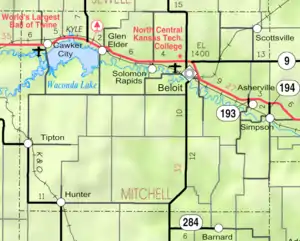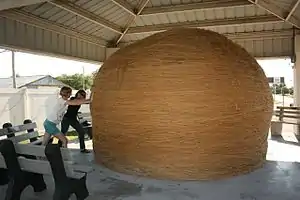Cawker City, Kansas
Cawker City is a city in Mitchell County, Kansas, United States.[1] As of the 2020 census, the population of the city was 457.[3] The city is located along the north shore of Waconda Lake and Glen Elder State Park. It is one of several places claiming to be home of the largest ball of twine in the world.[4][5][6]
Cawker City, Kansas | |
|---|---|
 Water Tower and Downtown (2012) (view from near the Ball of Twine) | |
 Location within Mitchell County and Kansas | |
 KDOT map of Mitchell County (legend) | |
| Coordinates: 39°30′34″N 98°25′59″W[1] | |
| Country | United States |
| State | Kansas |
| County | Mitchell |
| Founded | 1870 |
| Incorporated | 1874 |
| Named for | Colonel E.H. Cawker |
| Area | |
| • Total | 1.01 sq mi (2.61 km2) |
| • Land | 1.01 sq mi (2.61 km2) |
| • Water | 0.00 sq mi (0.00 km2) |
| Elevation | 1,493 ft (455 m) |
| Population | |
| • Total | 457 |
| • Density | 450/sq mi (180/km2) |
| Time zone | UTC-6 (CST) |
| • Summer (DST) | UTC-5 (CDT) |
| ZIP code | 67430 |
| Area code | 785 |
| FIPS code | 20-11175 |
| GNIS ID | 2393772[1] |
| Website | cawkercitykansas.com |
History
Cawker City was founded in 1870.[7] According to tradition, Colonel E. H. Cawker won naming rights for the town with a winning hand at poker.[8] Cawker City was incorporated as a city in 1874.[9] The first post office in Cawker City was established in June 1870.[10]
The city previously served many families living on small farms. A resident stated that Cawker City had three grocery stores in the 1960s. By 2017 the community had no grocery stores. Many young adults were leaving to find work elsewhere. In the area family sizes decreased and farm plot sizes increased. These factors caused the community's population to decline.[11]
Geography
According to the United States Census Bureau, the city has a total area of 1.00 square mile (2.59 km2), all of it land.[12] The city is located along the north shore of Waconda Lake.
Demographics
| Census | Pop. | Note | %± |
|---|---|---|---|
| 1880 | 1,039 | — | |
| 1890 | 898 | −13.6% | |
| 1900 | 816 | −9.1% | |
| 1910 | 870 | 6.6% | |
| 1920 | 788 | −9.4% | |
| 1930 | 739 | −6.2% | |
| 1940 | 657 | −11.1% | |
| 1950 | 691 | 5.2% | |
| 1960 | 686 | −0.7% | |
| 1970 | 726 | 5.8% | |
| 1980 | 640 | −11.8% | |
| 1990 | 588 | −8.1% | |
| 2000 | 521 | −11.4% | |
| 2010 | 469 | −10.0% | |
| 2020 | 457 | −2.6% | |
| U.S. Decennial Census | |||
2010 census
As of the census[13] of 2010, there were 469 people, 244 households, and 132 families residing in the city. The population density was 469.0 inhabitants per square mile (181.1/km2). There were 315 housing units at an average density of 315.0 per square mile (121.6/km2). The racial makeup of the city was 97.0% White, 0.2% African American, 0.2% Asian, 0.9% from other races, and 1.7% from two or more races. Hispanic or Latino of any race were 2.1% of the population.
There were 244 households, of which 19.3% had children under the age of 18 living with them, 40.6% were married couples living together, 7.0% had a female householder with no husband present, 6.6% had a male householder with no wife present, and 45.9% were non-families. 41.8% of all households were made up of individuals, and 19.6% had someone living alone who was 65 years of age or older. The average household size was 1.92 and the average family size was 2.52.
The median age in the city was 50.1 years. 18.6% of residents were under the age of 18; 4.5% were between the ages of 18 and 24; 17.9% were from 25 to 44; 32.4% were from 45 to 64; and 26.7% were 65 years of age or older. The gender makeup of the city was 51.4% male and 48.6% female.
2000 census

As of the census[14] of 2000, there were 521 people, 261 households, and 151 families residing in the city. The population density was 525.9 inhabitants per square mile (203.1/km2). There were 335 housing units at an average density of 338.2 per square mile (130.6/km2). The racial makeup of the city was 97.50% White, 0.19% African American, 1.73% Native American, 0.38% from other races, and 0.19% from two or more races. Hispanic or Latino of any race were 0.77% of the population.
There were 261 households, out of which 17.6% had children under the age of 18 living with them, 48.7% were married couples living together, 6.9% had a female householder with no husband present, and 41.8% were non-families. 37.9% of all households were made up of individuals, and 21.5% had someone living alone who was 65 years of age or older. The average household size was 2.00 and the average family size was 2.61.
In the city, the population was spread out, with 18.0% under the age of 18, 5.0% from 18 to 24, 19.8% from 25 to 44, 27.4% from 45 to 64, and 29.8% who were 65 years of age or older. The median age was 49 years. For every 100 females, there were 98.9 males. For every 100 females age 18 and over, there were 97.7 males.
The median income for a household in the city was $24,833, and the median income for a family was $30,769. Males had a median income of $25,893 versus $17,813 for females. The per capita income for the city was $13,693. About 12.3% of families and 11.6% of the population were below the poverty line, including 14.7% of those under age 18 and 8.3% of those age 65 or over.
Attractions

- Cawker City is one of several places claiming to be home of the largest ball of twine in the world. Each year a twine-a-thon is held in August to increase the size of the ball.
- Waconda Lake
- Odditorium and Monster Museum[15]
Education
The community is served by Waconda USD 272 public school district. The district elementary school is Lakeside Elementary school in Cawker City. The district high school is Lakeside High School (Kansas)|Lakeside High School in Downs with the mascot Knights.[16]
School unification combined Cawker City High School with Glen Elder High School in 1971 forming Waconda East High School. The Waconda East High School mascot was Vikings. Waconda East High School was then unified with Downs High School in 2003 forming USD 272.[17]
Prior to school unification, the Cawker City High School mascot was Cawker City Pirates.[18]
The elementary building was formerly known as Cawker City Elementary School.[19] Its name changed to the current one in 2015.[20]
Notable people
- Martia L. Davis Berry (1844-1894), social reformer
- Merwin Coad, Iowa politician
- Claire Windsor, silent film actress
References
- U.S. Geological Survey Geographic Names Information System: Cawker City, Kansas
- "2019 U.S. Gazetteer Files". United States Census Bureau. Retrieved July 24, 2020.
- "Profile of Cawker City, Kansas in 2020". United States Census Bureau. Archived from the original on March 31, 2022. Retrieved March 31, 2022.
- Heim, Michael (2007). Exploring Kansas Highways. p. 78. ISBN 9780974435886.
- Cawker City wins the ball game with massive sphere of twine; The Wichita Eagle; September 28, 2014.
- Twisted: The Battle to Be the World's Largest Ball of Twine; The Atlantic; September 9, 2014.
- Kansas State Historical Society (1916). Biennial Report of the Board of Directors of the Kansas State Historical Society. Kansas State Printing Plant. pp. 241.
- "Origin of Town Names" (PDF). Solomon Valley Highway 24 Heritage Alliance. p. 2. Retrieved April 9, 2018.
- Blackmar, Frank Wilson (1912). Kansas: A Cyclopedia of State History, Embracing Events, Institutions, Industries, Counties, Cities, Towns, Prominent Persons, Etc. Standard Publishing Company. pp. 301.
- "Kansas Post Offices, 1828-1961 (archived)". Kansas Historical Society. Archived from the original on October 9, 2013. Retrieved June 10, 2014.
- "A Thriving Rural Town's Winning Formula Faces New Threats Under Trump Administration". National Public Radio. February 19, 2017. Retrieved February 25, 2017.
- "US Gazetteer files 2010". United States Census Bureau. Archived from the original on January 25, 2012. Retrieved July 6, 2012.
- "U.S. Census website". United States Census Bureau. Retrieved July 6, 2012.
- "U.S. Census website". United States Census Bureau. Retrieved January 31, 2008.
- Eyegore's Odditorium and Monster Museum
- "Waconda USD 272". USD 272. Retrieved January 7, 2017.
- "History of Glen Elder" (PDF). Solomon Valley Highway 24 Heritage Foundation. Retrieved December 30, 2016.
- "Cawker City Returns Three", The Salina Journal, Cawker City Returns Three, p.11.
- Home. Waconda USD 272. April 9, 2002. Retrieved on February 25, 2017.
- Page, Dan (February 25, 2017). "Waconda District To Use Funds For Elementary Curriculum". Sunflower State Radio. Retrieved February 25, 2017.
Further reading
External links
- City of Cawker City
- Cawker City - Directory of Public Officials
- Cawker City's Biggest Attraction: World's Largest Ball of Twine
- Historic Images of Cawker City, Wichita State University Library
- Cawker city map, KDOT
